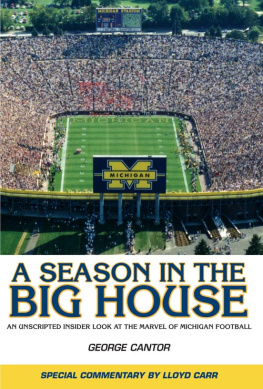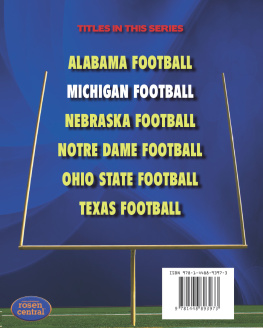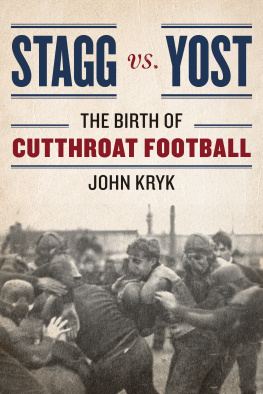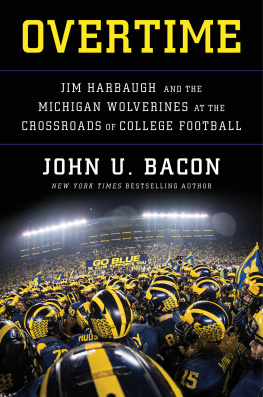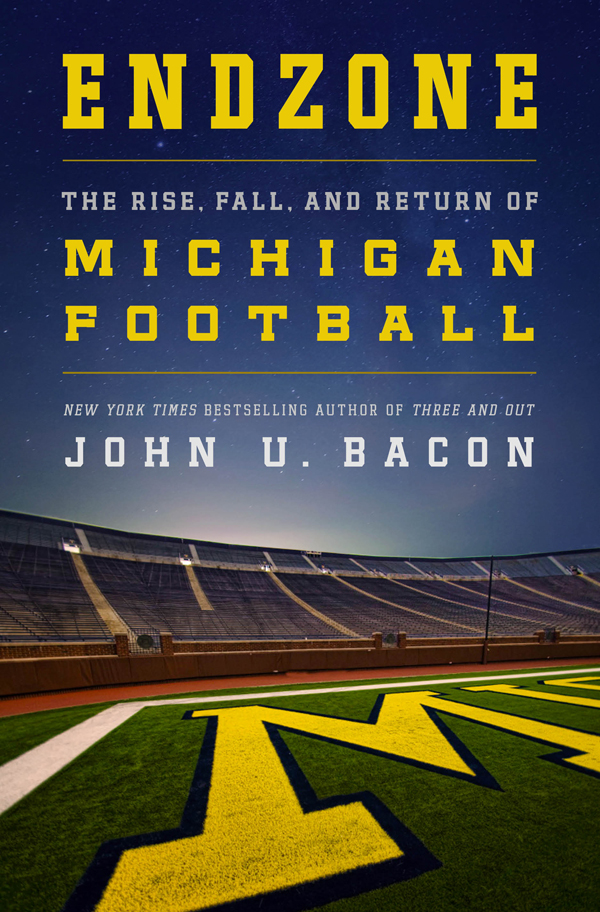Contents
Guide

The author and publisher have provided this e-book to you for your personal use only. You may not make this e-book publicly available in any way. Copyright infringement is against the law. If you believe the copy of this e-book you are reading infringes on the authors copyright, please notify the publisher at: us.macmillanusa.com/piracy.
For Christie
When people tell me Ive outkicked my coverage, and they always do, they have no idea how far.
With admiration, gratitude, and lovealways.
The jet cut through the clouds and eased onto the airstrip at Detroit Metro Airport, just a few miles from where Charles Lindbergh once tested World War II bombers.
This planes mission wasnt nearly so serious, of course. But the joy it gave to the people below seemed to exceed just about everything since V-J Day.
The jets cargo happened to be one James Joseph Harbaugh. Hes just a football coach, but that day he had done what so many experts said he would never do, right up until the minute he did it: leave the bright lights, big cities, and even bigger money of the NFL for the cornfields and college towns of the Big Ten. This decisionso mystifying to NFL reportersexplains why the masses might have been forgiven if they mistook Harbaugh for their savior.
But why did Harbaugh make that decisionand how did he even get the chance?
Most reporters kept saying there was no way Jim Harbaugh would ever bypass the NFL for Ann Arbor. It turns out their doubts were well foundedbut not for the reasons they offered. The odds against Harbaughs return really were astronomicalbut when a stunning series of departmental mistakes inspired a grassroots effort for reform, bold leaders stepped in to remove each obstacle, one by one. That it all happened just in time for Michigan to offer Harbaugh the chance to come home completed a chain of events that would have been impossible for anyone to predict even six months earlier.
That chain actually reaches back more than a century.
The University of Michigan was founded in 1817, and a band of students formed the schools first football team in 1879. The two have been inextricably linked ever since.
The university boasts world-renowned professors, researchers, and alumni500,000 strong, more than any university in the worldwith an endowment fast approaching $10 billion, and a QS Ranking as the nations top public university.
That university also claims the iconic banner, the band, and the Big Housethe biggest stadium in North Americanot to mention The Victors, the winged helmet, and the most wins in college football.
Arguably the nations greatest public university and its greatest college football program can both be found on the same campus in Ann Arbor, Michigan.
Michigan students, lettermen, alumni, faculty, and fans take a great deal of pride in that unique combinationand they watch the source of their pride very closely. They believe its not just Michigans victories that matteron and off the fieldbut the values behind them that are so important, values that place a premium on community, achievement, and integrity.
When they feel those values are threatened, they rise to defend them.
* * *
When dawn broke on Friday, November 17, 2006, the Michigan Wolverines stood atop the college football world.
They had notched the most wins in the sports history (871), the highest winning percentage (.735), the most conference titles (43) in the sports oldest, most storied league, the biggest stadium (107,501), the largest crowdsexceeding 100,000 for 251 straight games, going back to 1975the biggest revenues and, many believed, the most respect.
That morning, the Wolverines stood at 110, and were ranked second in the nation. A win over top-ranked Ohio State the next day, in the first Game of the Century, would give them a shot at a twelfth national title, which would provide a fine springboard for the complete renovation of the stadium, ensuring the Big House would remain the nations biggest and most profitable, for years to come.
Retired coach Bo Schembechler, the programs patriarch, gave the team a vintage speech Thursday night. But he did not spend much time on that weekends game, or the stakes involved. Instead, he talked to them about what it means to be a Michigan Man, and how becoming one was the ultimate goal of everyone in that room.
In Ann Arbor, life couldnt get much better.
* * *
The next morning, Friday, November 17, 2006, Bo Schembechler died from heart failure. For Michigan fans, the bad news has lasted almost a decade.
The next day, Michigan lost a nail-biter, 4239, to Ohio Statethen dropped the next three straight, including the 2007 season opener against Appalachian State, still considered the greatest upset in the history of college football.
When head coach Lloyd Carr retired after that season, Michigan hired Rich Rodriguez, whose troubled three-year run produced a 1522 record and a fractured fan base. In 2011, little-known Brady Hoke replaced Rodriguez and enjoyed a honeymoon season when the Wolverines beat the Buckeyes for the first time in eight years, and won a BCS bowl for the first time in twelve, to finish 112. But the next three seasons, the program slid steadily downhill, culminating in a 57 record in 2014, and Hokes dismissal.
Since the day Schembechler died eight years earlier to Hokes firing on December 2, 2014, mighty Michigan had gone 5548 overall, and 2433 in the Big Tennot the kind of numbers that had made Michigan the envy of its peers. Once the pride of a powerful conference, the Wolverines had become also-rans in an often overlooked league.
When the football program collapsed into almost unrecognizable mediocrity, its fall pulled the university itself into conflict, controversy, and crisis.
What went so wrong, so fast?
The losses, fans could see. But most of the problems that led to those losses were invisible to the publicas were their solutions, and the people who conceived them.
On January 5, 2010, University of Michigans president, Mary Sue Coleman, announced she had hired former Michigan football player, university Regent, and Dominos Pizza CEO Dave Brandon, ahead of three experienced athletic directors with strong Michigan ties, to become Michigans eleventh athletic director. She introduced him as the ideal candidate.
Brandon put his guiding principle, If it aint broke, break it! to work as soon as he took office, transforming Michigans rock-solid 135-year-old operation into a dazzling money machine, pushing revenues roughly 50 percent higher in just a few years, up to $150 million.
But Brandon also replaced loyal, experienced employees who had built great relationships with the students, the lettermen, the fans, and the media, with outsiders who quickly alienated all those groups. Just four years into Brandons tenure, the money started drying up, the fans stopped filling the Big House, and just about everyone was bailing on Brandons vision. In October of 2014, the students held a campus rally outside the home of recently hired President Mark Schlissel to demand he fire Dave Brandon.
It was not simply the 2014 teams 23 record to that point that had them upset, or they would have been asking for Hoke to be fired, not Brandon. It went deeper than that: They no longer had confidence the athletic director represented the values of the university they loved.
In different ways and at different times, the many constituents of Michigan football reached the same conclusion: This is not Michigan.


